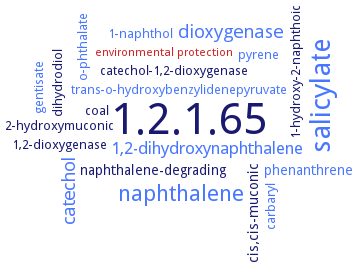1.2.1.65: salicylaldehyde dehydrogenase
This is an abbreviated version!
For detailed information about salicylaldehyde dehydrogenase, go to the full flat file.

Word Map on EC 1.2.1.65 
-
1.2.1.65
-
salicylate
-
naphthalene
-
dioxygenase
-
catechol
-
1,2-dihydroxynaphthalene
-
naphthalene-degrading
-
phenanthrene
-
cis,cis-muconic
-
trans-o-hydroxybenzylidenepyruvate
-
gentisate
-
catechol-1,2-dioxygenase
-
pyrene
-
1-hydroxy-2-naphthoic
-
o-phthalate
-
1-naphthol
-
2-hydroxymuconic
-
1,2-dioxygenase
-
carbaryl
-
coal
-
dihydrodiol
-
environmental protection
- 1.2.1.65
- salicylate
- naphthalene
- dioxygenase
- catechol
- 1,2-dihydroxynaphthalene
-
naphthalene-degrading
- phenanthrene
-
cis,cis-muconic
- trans-o-hydroxybenzylidenepyruvate
- gentisate
-
catechol-1,2-dioxygenase
- pyrene
-
1-hydroxy-2-naphthoic
- o-phthalate
- 1-naphthol
-
2-hydroxymuconic
-
1,2-dioxygenase
- carbaryl
-
coal
-
dihydrodiol
- environmental protection
Reaction
Synonyms
NAD+-dependent salicylaldehyde dehydrogenase, NahF, NahV, SAL dehydrogenase, SALD, SALDan, sALDH, salicylaldehyde dehydrogenase
ECTree
Advanced search results
General Information
General Information on EC 1.2.1.65 - salicylaldehyde dehydrogenase
Please wait a moment until all data is loaded. This message will disappear when all data is loaded.
evolution
network and phylogenetic analyses indicated that salicylaldehyde dehydrogenases (SALDs) and the homologues are present in bacteria and fungi, phylogenetic tree, distribution, and evolution of SALD, overview. Key residues in SALDs are analyzed by evolutionary methods and a molecular simulation analysis. The catalytic residue is most highly conserved, followed by the residues binding NAD+ and then the residues binding salicylaldehyde, molecular simulation analysis
malfunction
site-directed mutagenesis of selected residues binding NAD+ and/or SAL affects the enzyme's catalytic efficiency, but does not eliminate catalysis. Cys284 is positioned close to both NAD+ and SAL, implicating it as a potentially important residue
metabolism
physiological function
additional information
-
mineralization of naphthalene, detoxification of salicylaldehyde
metabolism
-
NahF catalyzes the last reaction in the conversion of naphthalene to salicylate
metabolism
pathway for the degradation of carbaryl via gentisate, overview. Various enzymes are involved in the metabolic pathway, including salicylaldehyde dehydroganse
metabolism
the salicylaldehyde dehydrogenases is involved in the naphthalene degradation pathway
metabolism
-
mineralization of naphthalene, detoxification of salicylaldehyde
-
metabolism
-
NahF catalyzes the last reaction in the conversion of naphthalene to salicylate
-
salicylaldehyde dehydrogenase is responsible for the oxidation of salicylaldehyde to salicylate using NAD+ as a cofactor in the naphthalene degradation pathway
physiological function
-
the enzyme catalyzes the oxidation of salicylaldehyde to salicylate in the carbaryl-degrading Pseudomonas sp. strain C6
substrate binding induces a conformational change
additional information
-
substrate binding induces a conformational change


 results (
results ( results (
results ( top
top






